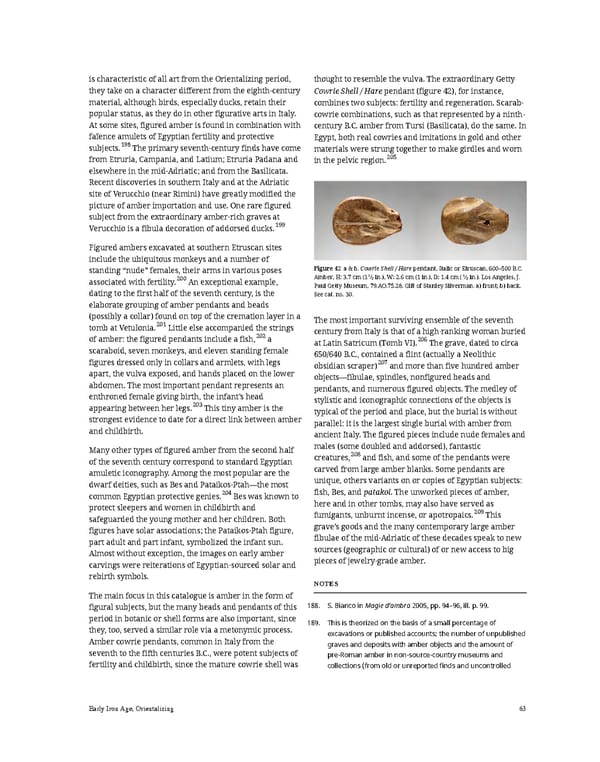is characteristic of all art from the Orientalizing period, thought to resemble the vulva. The extraordinary Getty they take on a character different from the eighth-century Cowrie Shell / Hare pendant (figure 42), for instance, material, although birds, especially ducks, retain their combines two subjects: fertility and regeneration. Scarab- popular status, as they do in other figurative arts in Italy. cowrie combinations, such as that represented by a ninth- At some sites, figured amber is found in combination with century B.C. amber from Tursi (Basilicata), do the same. In faïence amulets of Egyptian fertility and protective Egypt, both real cowries and imitations in gold and other subjects.198 The primary seventh-century finds have come materials were strung together to make girdles and worn from Etruria, Campania, and Latium; Etruria Padana and in the pelvic region.205 elsewhere in the mid-Adriatic; and from the Basilicata. Recent discoveries in southern Italy and at the Adriatic site of Verucchio (near Rimini) have greatly modified the picture of amber importation and use. One rare figured subject from the extraordinary amber-rich graves at Verucchio is a fibula decoration of addorsed ducks.199 Figured ambers excavated at southern Etruscan sites include the ubiquitous monkeys and a number of standing “nude” females, their arms in various poses Figure 42 a & b. Cowrie Shell / Hare pendant, Italic or Etruscan, 600–500 B.C. associated with fertility.200 An exceptional example, Amber, H: 3.7 cm (11⁄2 in.), W: 2.6 cm (1 in.), D: 1.4 cm (1⁄2 in.). Los Angeles, J. Paul Getty Museum, 79.AO.75.28. Gift of Stanley Silverman. a) front; b) back. dating to the first half of the seventh century, is the Seecat. no. 30. elaborate grouping of amber pendants and beads (possibly a collar) found on top of the cremation layer in a The most important surviving ensemble of the seventh tomb at Vetulonia.201 Little else accompanied the strings 202 century from Italy is that of a high-ranking woman buried of amber: the figured pendants include a fish, a at Latin Satricum (Tomb VI).206 The grave, dated to circa scaraboid, seven monkeys, and eleven standing female 650/640 B.C., contained a flint (actually a Neolithic figures dressed only in collars and armlets, with legs obsidian scraper)207 and more than five hundred amber apart, the vulva exposed, and hands placed on the lower objects—fibulae, spindles, nonfigured beads and abdomen. The most important pendant represents an pendants, and numerous figured objects. The medley of enthroned female giving birth, the infant’s head stylistic and iconographic connections of the objects is appearing between her legs.203 This tiny amber is the typical of the period and place, but the burial is without strongest evidence to date for a direct link between amber parallel: it is the largest single burial with amber from and childbirth. ancient Italy. The figured pieces include nude females and Many other types of figured amber from the second half males (some doubled and addorsed), fantastic creatures,208 and fish, and some of the pendants were of the seventh century correspond to standard Egyptian carved from large amber blanks. Some pendants are amuletic iconography. Among the most popular are the unique, others variants on or copies of Egyptian subjects: dwarf deities, such as Bes and Pataikos-Ptah—the most fish, Bes, and patakoi. The unworked pieces of amber, common Egyptian protective genies.204 Bes was known to protect sleepers and women in childbirth and here and in other tombs, may also have served as fumigants, unburnt incense, or apotropaics.209 This safeguarded the young mother and her children. Both grave’s goods and the many contemporary large amber figures have solar associations; the Pataikos-Ptah figure, fibulae of the mid-Adriatic of these decades speak to new part adult and part infant, symbolized the infant sun. sources (geographic or cultural) of or new access to big Almost without exception, the images on early amber pieces of jewelry-grade amber. carvings were reiterations of Egyptian-sourced solar and rebirth symbols. NOTES The main focus in this catalogue is amber in the form of figural subjects, but the many beads and pendants of this 188. S. Bianco in Magie d’ambra 2005, pp. 94–96, ill. p. 99. period in botanic or shell forms are also important, since 189. This is theorized on the basis of a small percentage of they, too, served a similar role via a metonymic process. excavations or published accounts; the number of unpublished Amber cowrie pendants, common in Italy from the graves and deposits with amber objects and the amount of seventh to the fifth centuries B.C., were potent subjects of pre-Roman amber in non-source-country museums and fertility and childbirth, since the mature cowrie shell was collections (from old or unreported finds and uncontrolled Early Iron Age, Orientalizing 63
 Ancient Carved Ambers in the J. Paul Getty Museum Page 72 Page 74
Ancient Carved Ambers in the J. Paul Getty Museum Page 72 Page 74